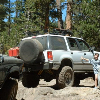david4451
Well-Known Member
- Joined
- February 9, 2015
- Messages
- 309
- Reaction score
- 46
- City, State
- cotabato philippines
- Year, Model & Trim Level
- 2001 ford sport trac
More than a year ago I fitted a pre-lube set up on my 2001 4wd Sport Trac. It had the timing chain rattle at START UP only.
From what I can see the most destructive problem for the 4l SOHC is timing chain failure, members are posting regularly about this design flaw. This is 100% due to no oil in the hydraulic tensioners at COLD START UP causing the "death rattle".
Ford knew about this and their fix was 1. No drain back filter(useless) 2. Oil restrictor in head(useless) 3. Improved timing chain plastic parts design(slight improvement 2002 on)
If you have a 4l SOHC, with rattle at cold start only and fit a pre lube set up the mostly catastrophic timing chain failure will be eliminated for many thousands of miles on ALL 4l SOHC.
Also it's useless putting new hydraulic tensioners in as they can't cope with the oil pressure required at cold startup.
For more information see post "Pre-lube and centrifugal oil filters"
Also check utube video "pre lube 2001 4wd sport trac"
From what I can see the most destructive problem for the 4l SOHC is timing chain failure, members are posting regularly about this design flaw. This is 100% due to no oil in the hydraulic tensioners at COLD START UP causing the "death rattle".
Ford knew about this and their fix was 1. No drain back filter(useless) 2. Oil restrictor in head(useless) 3. Improved timing chain plastic parts design(slight improvement 2002 on)
If you have a 4l SOHC, with rattle at cold start only and fit a pre lube set up the mostly catastrophic timing chain failure will be eliminated for many thousands of miles on ALL 4l SOHC.
Also it's useless putting new hydraulic tensioners in as they can't cope with the oil pressure required at cold startup.
For more information see post "Pre-lube and centrifugal oil filters"
Also check utube video "pre lube 2001 4wd sport trac"










